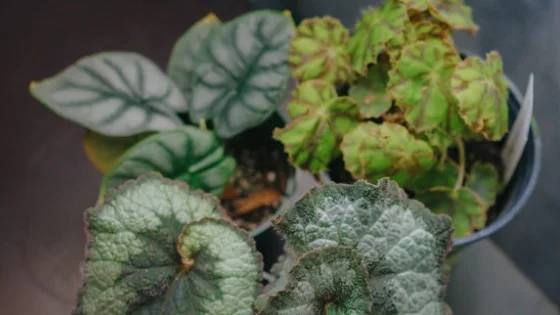Table of Contents
How to Care for Strawberry Begonia
The Strawberry Begonia belongs to the Saxifrage family and are well known for their decorative leaves.
These plants have fuzzy green-blue leaves. During the spring months and early summer, Strawberry Begonia will develop small flowers that are white in color.
Strawberry Begonia plant does not require much space, but it is a plant that sends out runners. They are very easy plants to care for although this is a plant that likes to expand and grows quickly.
What Does Your Strawberry Begonia Require?
Light Requirements
Strawberry Begonia plants tend to thrive in bright indirect sun light. These plants need to be kept out of direct sunlight as it can burn the leaves and cause holes.
Strawberry Begonia tends to thrive when placed on bright window sills. It is best to sit the plant in an east facing window if it’s not too dry or hot.
Temperature Requirements
Strawberry begonias tend to do better in cooler temperatures, and they will not do well when in hot temperatures.
It is a plant that prefers temperatures between four and eighteen degrees Celsius. These plants are dormant during the autumn and winter months.
Soil Requirements
It is best to use a well-aerated light soil that is designed for indoor houseplants. Soil that can retain the moisture whilst draining quickly is best for strawberry begonia plants.
If the chosen plant pot only has one large hole, then it’s a good idea to put some broken terra cotta in the bottom of the plant pot before adding the soil. The pieces of terra cotta will prevent the soil from running out when the plant is watered.
Humidity Requirements
Strawberry begonia plants tend to thrive in moderate to high levels of humidity. Although these plants like high humidity, they prefer cooler temperatures.
How to Water Strawberry Begonia?
When the top couple of inches of the soil in the Strawberry Begonia plants is moist, then avoid adding more water to them. When the top couple of inches of soil has dried out, then water the plant until the water comes out of the bottom through the drip holes.
Strawberry begonia will require less water during the autumn and winter months, as it is less active. Always water your Strawberry begonia from the bottom so that no water gets onto the hairs on the leaves.
During the winter months, the growth of your Strawberry begonia will reduce dramatically, or may even stop all together.
How to Fertilise Strawberry Begonia?
During the spring and summer months, fertilizer should be added to Strawberry Begonia plants, as this is when the plant is active. It is best to use a balanced food for indoor plants but only half the strength.
Avoid adding fertilizer to your Strawberry Begonia during the autumn and winter months.
During the growing season, fertilizer should be added to the plant once a month. The best fertilizer will include micronutrients and encourage the development of the bloom.
Extra Tips for Strawberry Begonia
Pests and Diseases
There are several pests and diseases that can affect your Strawberry Begonia plant, however they are fairly resistant to most problems.
Pests
Strawberry Begonias tend to be reasonably resistant to pests, however these plants can be affected by spider mites, mealybugs, and aphids.
If pests do appear on your Strawberry Begonia, then use an insecticidal soap at half of the recommended strength.
Diseases
It is possible for strawberry begonia plants to get bacterial and fungal diseases. The main cause of these problems is water collecting on the leaves of the plant, therefore always water the pant from the bottom.
Problems for Strawberry Begonias
It is important that the leaves on the strawberry begonias do not get wet as the dampness will encourage fungus to grow.
Pruning
Remove any dead, damaged, or yellow plants that develop on your strawberry begonia as soon as they appear. Dead leaves left on the plant can weaken the plant.
- A couple of weeks after planting, pinch off the new growth using thumb and finger. Remove the ends from the small stems which branch onto the main stem. This will encourage the new stems to sprout on each of the stems.
- When the Strawberry Begonia is fully grown thin out the foliage. If the plant becomes overgrown and bushy, then cut off up to a third of the stems, as this will make the plant look better and less overgrown.
- At the end of the growing season, take time to deadhead the plants. When the buds and flowers of the strawberry begonias turn brown and die off, then remove them. This removal can be done using fingers, scissors or pruning shears. This process will help the plant to reserve energy and focus on developing flowers and fresh growth.
- During the autumn months, the strawberry begonia can be cut back but this shouldn’t be done until flowering has finished. This cutting can be done using fingers, sharp scissors or pruning shears. Cutting back the plant like this will enable your Strawberry Begonia to reserve its energy during the winter.
Propagation
Strawberry begonia plants are best propagated through plant division. The easiest method of propagation for these plants is to plant the tiny baby plantlets that grow at the end of the runners.
Strawberry Begonia plants are very easy to propagate from the runners. It’s best to leave the runners attached to the parent plant, and pin down the plantlets onto the planting mix, which should be moist using a bent paper clip.
The plantlets will form roots within four weeks and form a new plant.
Seeds can be sown directly into the garden where they can be left to grow. The seeds can be planted during the spring months after the frost has passed.
Seeds can be sown indoors at any time of the year as long as they are kept in temperatures of between eighteen and twenty four degrees centigrade until they germinate. It can take between fifteen and twenty days for the plant to germinate.
Pot Size
Strawberry begonias do not tend to grow very big and tend to remain as a small compact plant. Although these plants don’t grow very tall, they do tend to send out several runners.
It is best to use a pot that is wider rather than deeper. The baby plants at the end of the runners will develop into smaller plants and grow near the mother plant. These plants are best to remain a little root bound as this will prevent over watering.
Repotting
Strawberry Begonia plants are fast growing therefore these plants can outgrow pots reasonably quickly. One sign that your Strawberry Begonia needs to be re-potted is when roots start to emerge from the drainage holes.
The plant can be slid out of the old pot when there are more roots than there is soil. The main rule of repotting is that the plant is moved into the next biggest size of pot.
Avoid using an excessively big plant pot as this can cause the plant to use its energy to grow roots rather than growing flowers and leaves.
FAQ
How Do You Care for Strawberry Begonias
Strawberry Begonia plants should be planted in an area where it gets partial shade to full shade. These plants can be used for ground cover.
Strawberry Begonia plants are best watered enough to maintain a medium level of moisture. The upper part of the soil should be allowed to dry out before more water is added.
Strawberry Begonia plants are best fertilized using an organic fertilizer. A two-inch layer of organic material should be added to the plant, but do not push it directly onto the stems.
If you do not want the plant to spread, then remove the runners before they can take root in the garden.
Do Strawberry Begonias Bloom?
Use bloom triggering fertilizer that has been correctly diluted to encourage the bloom of the plant.
To encourage your Strawberry Begonia to bloom during the spring months, water the plant during the winter months whilst ensuring that the leaves do not get wet.
When Strawberry Begonia plants bloom, they will produce white flowers, which usually happens during the spring months.
Are Strawberry Begonias Indoor or Outdoor Plants?
Strawberry Begonias can be grown as either an indoor plant or an outdoor plant. When these plants are kept indoors, an east facing window sill is ideal or even in the porch if possible.
Strawberry Begonia can also make a lovely hanging feature for indoor areas.
Strawberry Begonias can be planted outdoors and can make excellent ground coverage. This begonia will thrive when it has bright light, but it should not be placed in direct sunlight. Direct light is not good for Strawberry Begonias as it can burn the leaves.
How Do You Keep Begonias Alive?
There are several things that you can do to keep your strawberry begonias alive. These plants do not tolerate sudden change in temperature or cold temperatures, therefore it’s a good idea to bring the plants indoors when the temperatures are below ten degrees centigrade.
Strawberry Begonia plants are best kept in partially sunny areas with a high level of humidity. As the temperatures get colder these plants should be kept indoors for an increasing amount of time.
Dead blooms and brown stems should be removed from these plants.
Photo by Dex Ezekiel on Unsplash


